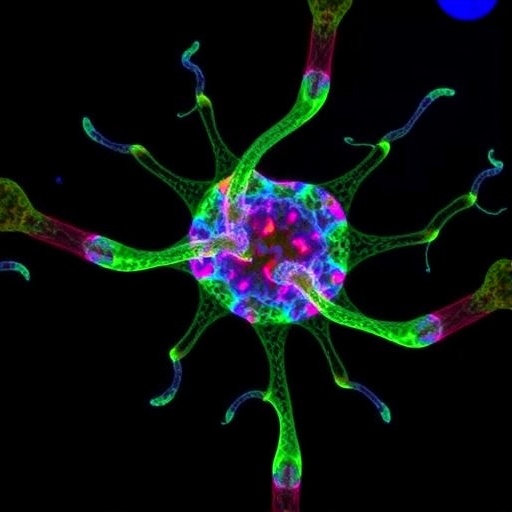In a groundbreaking study, scientists have turned their attention to the molecular intricacies of head and neck squamous cell carcinoma (HNSCC), highlighting an innovative approach that promises to enhance cancer treatment efficacy. The researchers from Hu, W., Huang, Q., Chen, L., and their colleagues have discovered that inhibiting discoidin domain receptor 1 (DDR1) can potentiate the effects of carbon ion radiotherapy, a method that is gradually gaining prominence in oncology. This novel strategy not only boosts the therapeutic impact of radiotherapy but also instigates mechanisms of cell death that could have significant implications for the future of cancer treatments.
HNSCC is notorious for its aggressive behavior and the challenges it poses to oncologists. The average patient prognosis remains disheartening with limited treatment options available. Traditional chemotherapy and radiotherapy often fall short of providing long-lasting solutions, necessitating a deeper exploration into the molecular targets that drive cancer progression. The study emphasizes that understanding the underlying biology of these tumors is essential for developing more effective therapies, particularly concerning DDR1’s role in the tumor microenvironment.
DDR1 is a receptor tyrosine kinase that has recently come into the spotlight for its involvement in cancer cell survival and proliferation. The research team found that DDR1 is overexpressed in HNSCC, which correlates with poor patient outcomes. By targeting this receptor, they aimed to disrupt signaling pathways that facilitate tumor growth and resistance to conventional treatment methods. Their findings represent a potential paradigm shift in how clinicians might approach HNSCC, particularly in considering combination therapies that integrate molecular targets with existing treatment modalities.
Intriguingly, the team demonstrated that inhibiting DDR1 can enhance carbon ion radiotherapy’s effectiveness by inducing ferroptosis, a form of regulated cell death characterized by iron-dependent accumulation of lipid peroxides. Ferroptosis presents a unique opportunity in cancer therapy, as it operates through a distinct mechanism compared to apoptosis and necrosis. This research indicates that disrupting DDR1 could disrupt the cancer cell’s defensive mechanisms against oxidative stress, ultimately leading to a more substantial therapeutic response when combined with carbon ion therapy.
Carbon ion radiotherapy itself is an advanced cancer treatment modality that offers several advantages over conventional photon therapies. The precision with which carbon ions can kill cancer cells while sparing adjacent healthy tissues has made it a focus of interest in oncological research. The study posits that combining this advanced radiotherapy with DDR1 inhibition could significantly impact HNSCC treatment outcomes by maximizing tumor cell death while minimizing collateral damage to surrounding healthy tissue.
In addition to promoting ferroptosis, the inhibition of DDR1 also appears to trigger a phenomenon known as immunogenic cell death. This form of cell death creates a pro-inflammatory environment that can enhance anti-tumor immunity. The interaction between the immune system and tumor cells is complex, but understanding and leveraging this relationship could lead to improved clinical outcomes. By making cancer cells more visible to the immune system, the potential for tumor eradication increases, offering hope for enhanced survival rates among patients.
Conducting a series of in vitro and in vivo experiments, the researchers meticulously analyzed the impact of DDR1 inhibition on tumor growth and response to carbon ion therapy. Their results underscored the promise of this dual approach, demonstrating not only a reduction in tumor size but also changes in the immune cell composition within the tumor microenvironment. Such findings pave the way for clinical trials to rigorously assess the safety and efficacy of combining DDR1 inhibitors with carbon ion radiotherapy in HNSCC patients, which could potentially lead to regulatory approvals within a few years.
The implications of this study extend beyond HNSCC. The concept of combining targeted therapies with established treatment solutions may be applicable to various cancers characterized by DDR1 aberrations. As researchers continue to unveil the complexities of tumor biology, targeted therapies are emerging as critical components in the oncologist’s toolkit. The hope is that breakthroughs such as this can lead to personalized treatment regimens tailored to an individual patient’s tumor profile, enhancing efficacy while reducing unnecessary toxicity.
Moreover, as the scientific community begins to embrace these innovative treatment paradigms, the integration of multi-disciplinary approaches in cancer care becomes increasingly evident. Oncologists, geneticists, immunologists, and radiologists must collaborate to formulate strategies that are not only effective but also take into account the intricacies and heterogeneity of cancer diseases. Harnessing the insights gained from this research serves to reinforce the necessity of such collaborations in pushing the boundaries of what is possible in cancer therapy.
With the possibility of moving into clinical trials, this research stands at the forefront of promising future developments in cancer treatment. The excitement surrounding these findings is palpable, not only within the academic community but also among patients and advocacy groups eagerly awaiting advancements in cancer care. The prospect of improved survival rates and reduced treatment side effects reflects the broader goal of modern oncology: to transform cancer from a formidable foe into a manageable condition.
The potential impact of this study cannot be understated as it embodies the essence of translational medicine—where bench research informs clinical applications that ultimately benefit patients. It signals a progressive step forward in the synergistic relationship between fundamental research and clinical practice, as effective therapies are developed from insights gained through rigorous scientific exploration. As this research advances, the broader implications for cancer treatment will surely unfold, revealing even more opportunities to harness our understanding of molecular mechanisms for patient benefit.
In summary, this innovative study offers a promising avenue for enhancing carbon ion radiotherapy through the inhibition of DDR1, illustrating the multifaceted roles of cell death mechanisms in cancer therapy. By elucidating how ferroptosis and immunogenic cell death can be harnessed to combat HNSCC, the researchers contribute significantly to the evolving landscape of cancer treatment strategies. Their work exemplifies how focused research on molecular targets can catalyze the development of more potent, targeted therapies that may one day revolutionize the approach to treating various cancers, paving the way for improved patient outcomes.
Subject of Research: Head and neck squamous cell carcinoma (HNSCC) treatment.
Article Title: Inhibition of DDR1 potentiates carbon ion radiotherapy by promoting ferroptosis and immunogenic death in head and neck squamous cell carcinoma.
Article References:
Hu, W., Huang, Q., Chen, L. et al. Inhibition of DDR1 potentiates carbon ion radiotherapy by promoting ferroptosis and immunogenic death in head and neck squamous cell carcinoma.
J Transl Med 23, 1011 (2025). https://doi.org/10.1186/s12967-025-07062-5
Image Credits: AI Generated
DOI: 10.1186/s12967-025-07062-5
Keywords: DDR1, carbon ion radiotherapy, ferroptosis, immunogenic death, head and neck squamous cell carcinoma, cancer treatment, targeted therapies, oncological research.
Tags: aggressive behavior of head and neck squamous cell carcinomacarbon ion therapy for cancer treatmentcell death mechanisms in cancer treatmentchallenges in oncological treatment optionsdiscoidin domain receptor 1 role in HNSCCenhancing radiotherapy efficacyfuture implications of cancer researchinhibiting DDR1 in head and neck cancerinnovative cancer treatment strategiesmolecular targets in cancer therapyreceptor tyrosine kinase in cancertumor microenvironment and cancer progression





